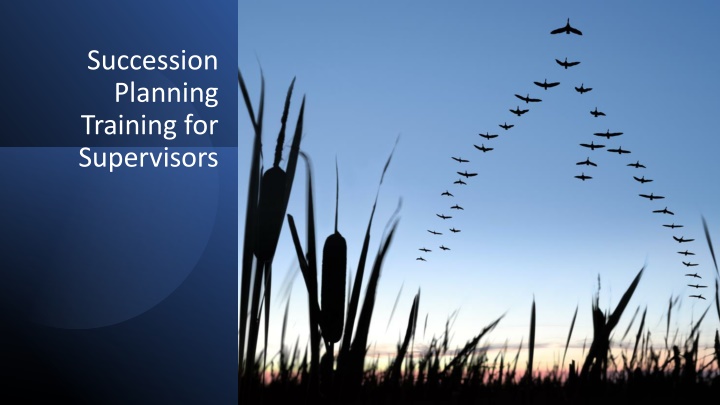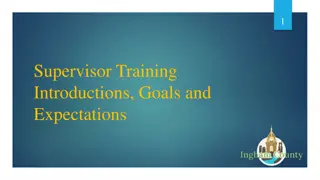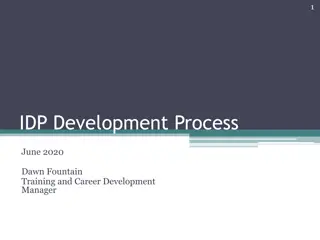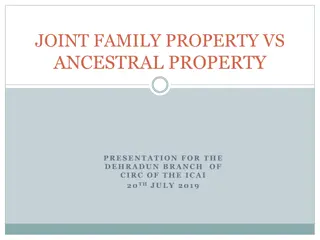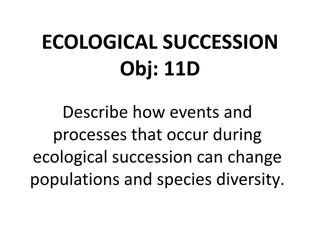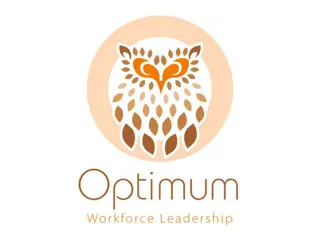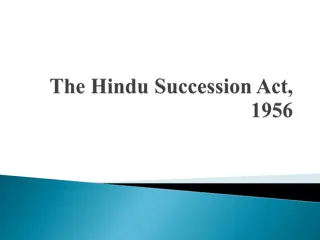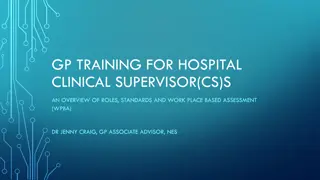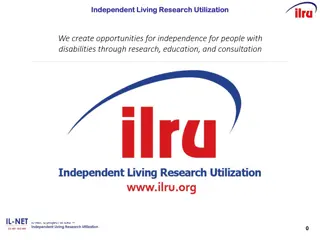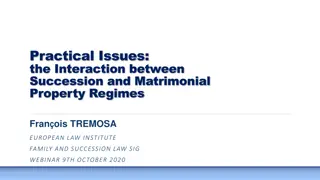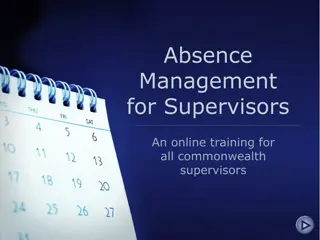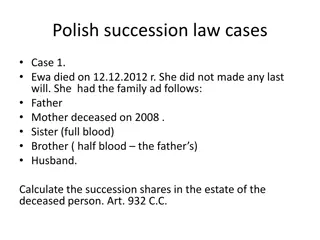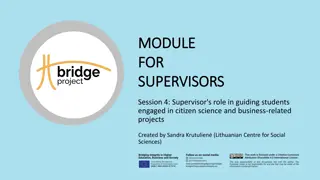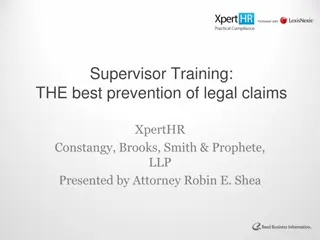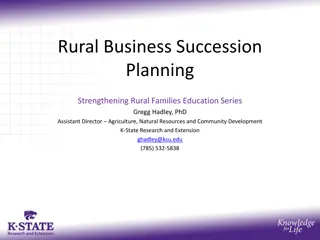Comprehensive Succession Planning Training for Supervisors
This succession planning training for supervisors emphasizes the critical task of planning for key role absences within an organization. It delves into the importance of formal succession planning, outlining steps involved, such as identifying high-potential employees, keeping the plan current, and communicating it effectively. The training highlights the significance of succession planning in maintaining business continuity and achieving long-term goals through workforce development and diversity considerations.
Download Presentation

Please find below an Image/Link to download the presentation.
The content on the website is provided AS IS for your information and personal use only. It may not be sold, licensed, or shared on other websites without obtaining consent from the author.If you encounter any issues during the download, it is possible that the publisher has removed the file from their server.
You are allowed to download the files provided on this website for personal or commercial use, subject to the condition that they are used lawfully. All files are the property of their respective owners.
The content on the website is provided AS IS for your information and personal use only. It may not be sold, licensed, or shared on other websites without obtaining consent from the author.
E N D
Presentation Transcript
Succession Planning Training for Supervisors
Succession Planning Training WELCOME! 2
Introduction Planning for both the foreseen and unexpected absences of individuals who hold key roles in an organization is a task that we as employers often avoid or engage in only in an informal manner. Without concentrated effort on this activity, known as succession planning, a business that has been successful can quickly fail if it loses one or more of its leaders. 3
Introduction (cont.) When succession planning is carefully conducted and the plan periodically reviewed, organizations can avoid extended and costly vacancies. Succession planning must be a priority for every employer and should be part of its strategic business plan. This presentation stresses the importance of succession planning and provides you with information on how to conduct this business activity. 4
Agenda What is succession planning? The importance of a plan. Steps involved in succession planning. Keeping the plan current. Communicating the plan to employees. 5
What is Succession Planning? Succession planning is the process of identifying high-potential employees, evaluating and honing their skills and abilities, and preparing them for advancement into positions that are key to the success of business operations and objectives. Succession planning involves: Understanding the organization s long-term goals and objectives. Identifying high-potential candidates and their respective developmental needs. Determining workforce trends and predictions. 6
The Importance of a Plan An effective succession plan can help an employer: Avoid extended and costly vacancies in key positions and ensure the stability of business operations. Provide meaningful developmental opportunities for both the organization and its employees as it targets key leadership positions at varying levels. Help develop a diverse workforce by enabling decision-makers to look at the future makeup of the organization as a whole. 7
Steps Involved in Succession Planning 1. Identifying legal and diversity issues to consider. 2. Establishing present and future leadership roles and objectives. 3. Selecting high-potential employees. 4. Evaluating readiness for succession in high-potential employees. 5. Planning for the individual development of retention of high- potential employees. 6. Identifying emergency positions without successors. 7. Planning for positions that cannot be filled internally. 9
Identifying Legal and Diversity Issues Step 1: Identifying Legal and Diversity Issues When positioning employees for succession, avoid like-me approaches. Use assessment tools to reduce biased selection practices. Train leadership on recognizing hidden biases. Discrimination laws require inclusion of all qualified employees regardless of race, gender or other protected classes. 10
Establishing Present and Future Leadership Roles and Objectives Step 2: Establishing Present and Future Leadership Roles and Objectives Ask questions to assess what tomorrow s organization and roles may look like: How will the state of the industry and economy today affect the business operations in the next one to five years? Which operations are critical to the future of the organization? Will operations be discontinued or downsized, or will they grow or remain constant? 11
Establishing Present and Future Leadership Roles and Objectives (cont.) Step 2: Establishing Present and Future Leadership Roles and Objectives (cont.) How will reengineering, process improvement or technology affect the business in the future? What job functions, if any, will be consolidated? Will the projected workload volume increase or decrease? Will staffing levels change? If so, how? Which skills and abilities will the organization need to match these changes? 12
Selecting High-Potential Employees Step 3: Selecting High-Potential Employees The incumbents in key positions identify employees available for succession into their positions. The organization develops a profile of candidates including a history of performance reviews and accomplishments as well as relevant experience, education and credentials. Cross-departmental leadership/key decision-makers must be involved throughout the planning process to represent their selections and discuss concerns with one another. Employers need to plan for identifiable gaps in the event of an emergency replacement of a candidate in another department. 14
Selecting High-Potential Employees (cont.) Step 3: Selecting High-Potential Employees (cont.) Selection is based on available candidates. Some available candidates will be ready, whereas some will not meet the demands of critical positions. In some cases, no identifiable candidate will be available for succession. A common method used to chart the available candidates and their readiness level to succeed is a nine-box grid. The nine-box grid helps management visualize the available successors along with the strengths/weaknesses in the plan. The next slides display a sample nine-box grid and a readiness chart. 15
9-Box Grid Underperformance Effective Performance Outstanding Performance High Potential Box 5: Box 2: Box 1: Consistently performs well in a variety of assignments. A superstar employee, big-picture thinker, problem solver, self-motivated. Seasoned professional capable of expanded role but may be experiencing problems that require coaching and mentoring. Does extremely well at current job with potential to do more. Give stretch assignments to help prepare for next level. Medium Potential Box 8: Box 6: Box 3: With coaching, could progress within level. Focus on stretch goals for this employee. May be considered for job enlargement at the same level, but may need coaching in several areas, including people management. Current role may still provide opportunity for growth/development; focused on tactical. Focus should be on helping improve strategic thinking. Box 9: May be a candidate for reassignment, reclassification to a lower level or to exit the organization. Box 7: Effective performer but may have reached career potential. Try to coach employee on becoming more innovative, focused on lateral thinking. Box 4: Experienced high performer but has reached limit of career potential. Still a valuable employee and can be encouraged to develop communication and delegation skills. Low Potential 16
Example Readiness Level Chart Key position title Incumbent name Anticipated vacancy date Succession candidate name Anticipated date candidate will be ready for succession Example: Director of Human Resources Andrea Rodriguez January 2025 Juanita Goldsmith January 2024 17
Evaluating Readiness for Succession in High- Potential Employees Step 4: Evaluating Readiness for Succession in High-Potential Employees Once organizations identify candidates for succession and the skills required for current and future succession, they can use assessment tools to determine skill deficiencies that may presently exist. Approaches may include: 360-degree surveys that include feedback from peers, direct reports, line management and other relevant sources, such as clients, customers, vendors and/or suppliers. Leadership evaluations by an independent third-party consultant. Existing performance review information and feedback from management. 19
Planning for the Individual Development and Retention of High-Potential Employees Step 5: Planning for the Individual Development and Retention of High-Potential Employees Once employers identify strengths and weaknesses, they should create action plans for developing strengths and reducing weaknesses. Common action plans include leadership development programs and skill-specific educational programs but may also include an internal mentoring program. 20
Sample Performance Summary Overall Performance Summary: (Indicate recent performance including major accomplishments or performance issues.) Key Strengths: (Indicate key technical or professional competencies, skills or knowledge the person has.) Development Needs: (Indicate key experiences, skills or knowledge the person lacks to move to the next level.) Development Actions: (List new responsibilities to be assigned, projects or special assignments, and/or training programs recommended.) Potential for Promotion: (Indicate this person s readiness to be promoted and the anticipated readiness date.) Recommended Next Position: (List the next assignment that would most benefit the individual in his or her development.) 21
Identifying Emergency Positions Without Successors Step 6: Identifying Emergency Positions Without Successors Emergency positions are those in which no successor is available or no successor with development potential exists. Emergency positions are critical because the organization has already determined the key roles and future organizational needs. When a succession plan has a vacancy, the organizational operations may be at risk in the event of a departure. 23
Planning for Positions That Cannot Be Filled Internally Step 7: Planning for Positions That Cannot Be Filled Internally If no internal successor exists, the organization will need to consider external recruitment strategies, and in the interim, consider cross- departmental succession opportunities. While an external candidate may have the technical knowledge and experience for a particular position, they will lack familiarity with the organizational culture and day-to-day operations. However, recruiting external talent can be beneficial in that it allows the employer to bring fresh ideas and diverse talent into the organization. 24
Keeping the Plan Current How will the plan be kept current? Develop a recurring time frame for reviewing the plan, whether semiannually or annually. Determine the effectiveness of the existing plan. Determine whether the current plan still meets the organizational objectives. Determine whether the candidates have changed and make necessary adjustments in the plan. Assess and develop new candidates. 26
Communicating the Plan to Employees Determine the method of communication (e.g., all-staff meetings, employee newsletter, public affairs announcement). Take this opportunity to inform employees about the benefits of developing a succession plan and how it affects them. Communication will help employees recognize that the organization s management looks toward the future with optimism and invests in employee development and growth. 28
Summary Succession planning is the process of identifying high-potential employees, evaluating and honing their skills and abilities, and preparing them for advancement into positions that are critical to the success of business operations and objectives. Having a well-developed and current succession plan in place is important in avoiding vacancies in key positions, ensuring the stability of business operations, providing developmental opportunities and helping to develop a diverse workforce. 30
Summary (cont.) Seven steps are involved in succession planning pertaining to legal and diversity issues, identifying key leadership roles, evaluating the potential of employees, and selecting and developing employees to fill these key roles when needed. Once an organization develops a workable succession plan, it must keep it current and communicate it to all employees. 31
Training Evaluation Please complete the training evaluation sheet included in the handouts. Thank you for your interest and attention! 32
